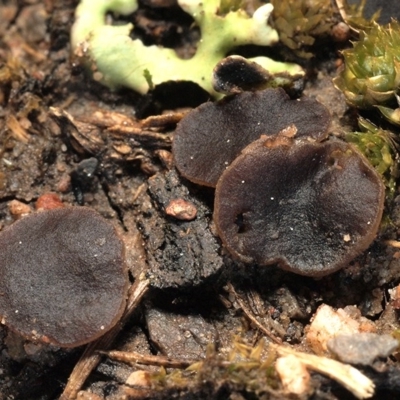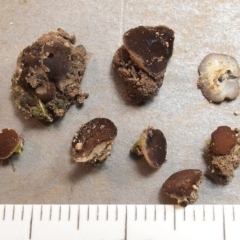Phaeohelotium succineoguttulatum
The fruitbody consists of a flat to slightly convex disc atop a stem. The disc is reported to grow up to 11 millimetres in diameter, but mostly is smaller. Its upper surface is brown (e.g. ochre, red-brown, blackish-brown) and the underside is very pale. The stem is white, up to a few millimetres long and may be quite broad. When the stem is very short the whole fruitbody resembles a truncated, upside-down cone.
The fruitbody has a fleshy texture.
Fruit bodies appear on soil and may grow as separated individuals or as small groups of abutting fruit bodies. The original description of this species was published in the Baral et al paper and was based on specimens collected amongst eucalypts in Spain.
Two closely related yellow Phaeohelotiums (https://canberra.naturemapr.org/species/10117) are found in the Canberra Nature Map area. Baral et al note that with age their fruitbodies may become a little brownish, but not the dark shades found in Phaeohelotium succineoguttulatum.
Reference
Baral, H.O., Galan, R., Platas, G. & Tena, R. (2013). Phaeohelotium undulatum comb. nov. and Phaeoh. succineoguttulatum sp. nov., two segregates of the Discinella terrestris aggregate found under Eucalyptus in Spain: taxonomy, molecular biology, ecology and distribution, Mycosystema, 32, 387-428.
Some technical details from Baral et al
Their molecular analysis puts the yellow Phaeohelotium undulatum close to Phaeohelotium succineoguttulatum. Both species have asci with simply septate bases and the spores are consistently hyaline when inside living asci (and over-mature spores are brown). The upper parts of live paraphyses of succineoguttulatum contain globose, yellow-brown refractive bodies and in the paper you read: "these persistent in dead cells when mounted in H2O, bright to dark yellowish- or reddish-brown, very conspicuous, in KOH refractivity and pigmentation strongly or only slightly diminished". In undulatum there are globose to elongate, hyaline refractive bodies (which are KOH soluble but persist in dead cells and may then be hyaline to pale yellowish when mounted in water). The asci of succineoguttulatum show no amyloid reaction whereas the asci of undulatum are predominantly or consistently amyloid.
Phaeohelotium succineoguttulatum is listed in the following regions:
Canberra & Southern Tablelands
Species information
- Phaeohelotium succineoguttulatum Scientific name
- Common name
- Not Sensitive
- Local native
- Non-invasive or negligible
- Up to 611m Recorded at altitude
- Machine learning












